“What’s the best time to send emails in 2025?”
Struggling to find the best time to send emails? Welcome to the unofficial hub for frustrated marketers.
In this blog, we share proven strategies to help make your journey to success clearer and less frustrating. Plus, you save a lot on your email marketing cost per month using our methods. That for us, is satisfying.
With that said let’s jump right in…
Email marketing success takes more than just creating compelling email content. Creating engaging emails is one thing, but nailing the timing makes the difference between success and failure.
Research shows people read only one in five emails within the hour. So while seemingly insignificant, deciding when to send your “engaging” email can make or break your marketing game.
Your email send time directly affects your open rates, click-through rates, and deliverability. Getting it right can turn an ignored email into one that drives conversions and boosts customer engagement.
Like many of our clients here at Abervin Digital, you’re probably asking, “What is the best time to send emails?”
The truth is, there isn’t a one-size-fits-all answer. The best time to send marketing emails in 2025 depends on your audience, email type, and industry. We’ll go into it on detail shortly.
So if you’re searching for your email timing sweet spot, keep reading, this guide will help you find it.
We’ll discuss practical tips, data-backed insights, and unique strategies to ensure your email lands at the right moment, every time. But first…
Why Does Finding the Best Time to Send Emails Matter?
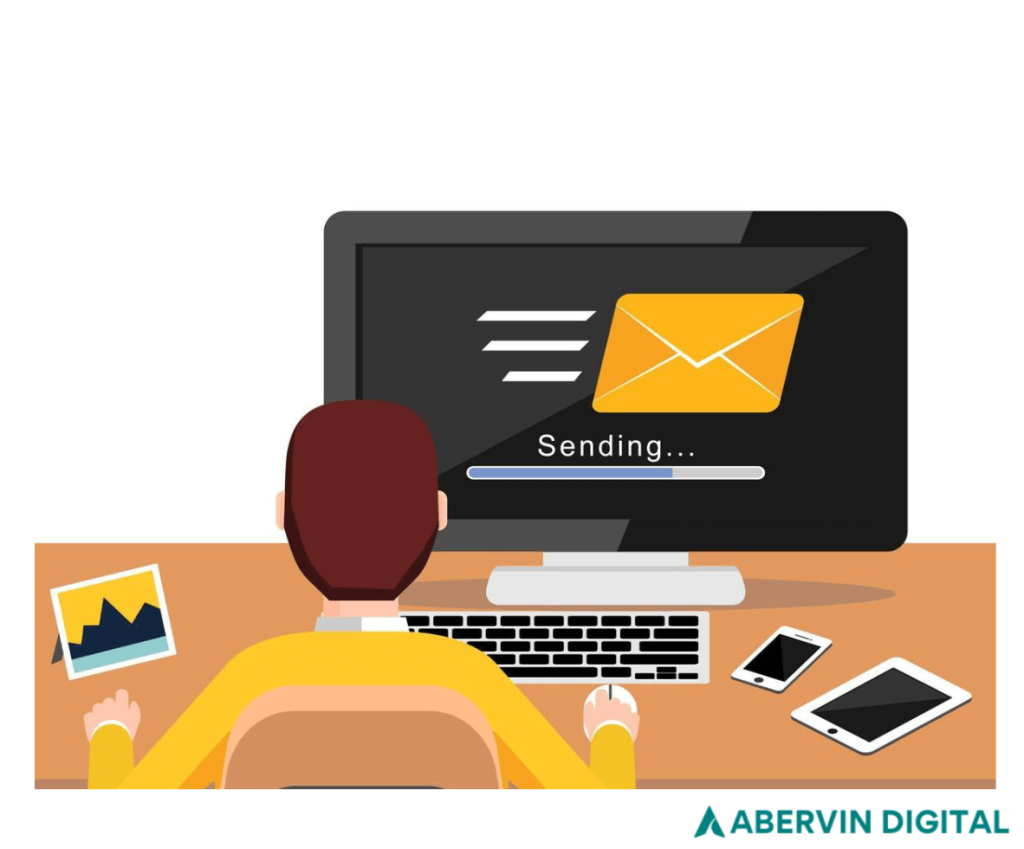
It’s very tempting to just hit send as soon as you’re done with your beautifully designed HTML email.
But without finding the best time to send emails to your audience, even the most beautiful email design may fail. It’s like trying to sell ice cream at midnight in winter… wrong timing, right? It’s pretty much the same thing for your email marketing campaigns.
Choosing the right time to send your emails gets you to higher open rates. When you time emails right, you give your audience a better experience. Plus, your content has the best chance to make an impact.
With that in mind, let’s discuss the three key reasons timing is important for EVERY successful email marketing strategy:
You Get Better Content Visibility By Timing Your Emails to Fit Your Audience’s Routine.
Every email you create competes with countless others. Sending at the right time gives your campaign the highest chance of being read.
For better email content visibility, research your audience and build an ideal customer profile. Identify when they check emails. For instance, a stay-at-home parent might skim their inbox in the evening after the kids are asleep. On the other hand, a small business owner might check theirs early in the morning.
Match your send times to these routines to increase the chances that your recipient will see your message and act.
Improve Deliverability By Avoiding the Email Pile-Up.
Here’s a cool stat for you… The average office worker receives upwards of 100 emails daily!
Sending during peak times can overwhelm email providers. This could delay delivery and hurt your sender reputation.
Choosing less busy times helps emails reach inboxes faster. Plus, sending when people actively check email increases opens, clicks, and conversions.
Figure out the best time to reach your audience and you’ll stay out of the spam folder. There are a few more ways to improve your email deliverability and we’ve put that together in this blog here.
Get Better Engagement with well-timed sending
Visibility and Deliverability are one thing but engagement is what you really want!
Let’s take a moment to walk a mile in the recipients shoes.
Imagine receiving an email from a vendor buried among 20 other work-related email. How likely are you to open that email, read it thoroughly, and take action? The chances are slim to none.
The same principle applies to your clients. If your email reaches them at a hectic time, they will likely overlook, ignore, or forget it. Knowing the best time to send emails is everything when it comes to ensuring your message gets the attention it deserves.
Emails sent at the right time have higher engagement and better chances for conversions. They also provide helpful insights to refine your email marketing strategy. When you understand your audience’s active times, you can send emails that match their daily routines.
For example, an audience of young professionals might engage more during their lunch breaks, while customers for your eCommerce business may be more active on Saturday mornings.
So what this means is, If you send an email to young professionals on Monday morning, it may land in their inbox. That’s good for deliverability. But since they’re busy planning their day, they rarely have time to read it. Emails sent at that time often see low engagement.
Choosing a high engagement time helps your emails get delivered, seen, engaged with, and acted upon.
Wondering where to start? Great! Let’s go over some of the latest insights on the best time to send marketing emails. These tips are backed by research and real-world trends.
Best Days & Time Of The Day to Send Emails – by Industry
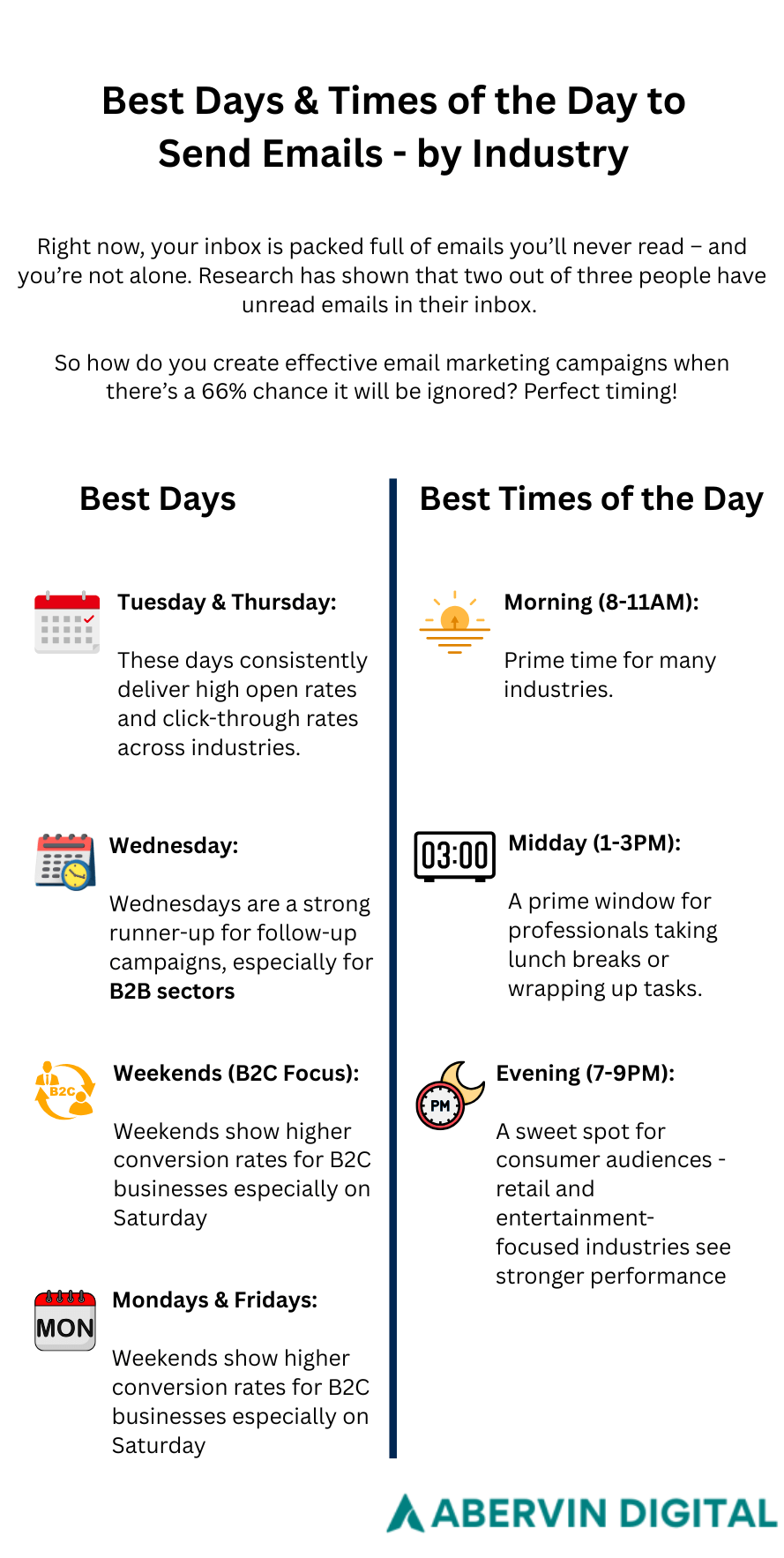
Right now, your inbox is packed full of emails you’ll never read – and you’re not alone. Research has shown that two out of three people have unread emails in their inbox.
So how do you create effective email marketing campaigns when 66% of recipients may ignore them? Perfect timing!
The best time to send emails can vary by days, industry, type of email, audience behavior, and campaign objectives.
Let’s discuss the best days and times to send emails based on industry wisdom and proven campaigns:
Best Days
Tuesday & Thursday
These days consistently deliver high open rates and click-through rates across industries. For B2B, midweek sending means your email lands during working hours when decision-makers are most focused. According to Salesforce data, professionals are most likely to engage with communications between Tuesdays and Thursdays during the work week. This is when they typically catch up on priorities and are more available to respond. Data shows Tuesday leading with ~19% average open rates.
Wednesday
Wednesdays are a strong runner-up for follow-up campaigns, especially for B2B sectors. These emails split the workweek evenly, giving recipients time to engage. So let’s say you are promoting your startup to C-Suite employees in Silicon Valley. Send your first cold email on Tuesday and follow up with your prospects on Wednesday. This strategy gets you a higher chance at conversions.
Weekends (B2C Focus)
E-commerce and retail businesses often see high conversion rates when they send weekend emails, especially Saturday mornings. This is when users have more leisure time. Evening B2C emails targeting promotions or lifestyle products tend to stand out because inbox competition is lower. This is especially true for audiences unwinding after busy weeks.
Here at Abervin Digital, one creative strategy we’ve had good success with is sending eCommerce emails to office inboxes over the weekend. The unexpected timing works in our favor, even if it isn’t the best time to send emails. It works because office workers get fewer emails at their work address during that time. We stand out when no one else is reaching them. But be careful when deploying this strategy as overuse can lead to recipient dissatisfaction. If you’d like to learn more about some of the methods we use to scale eCommerce businesses, we’ve put together our 11 expert approved ecommerce secrets here.
Mondays & Fridays
On Mondays, emails can get lost because everyone already has a pile from the weekend. But some professionals engage more if they receive emails after the morning rush (10 a.m. onwards). Sending emails on Fridays can sometimes work, however most recipients are mentally clocking out for the weekend. Friday afternoons also works for B2C audiences prepping for weekend shopping.
Pro Tip: Some of the best email marketing software for 2025 allow you segment your audience based on behavior. Weekend shoppers vs. weekday decision-makers require different strategies.
Best Times of the Day
Morning (8–11 AM)
This is the “prime time” for most industries, as people often check emails first thing in the morning. For B2B, sending around 8 AM captures inbox space before other distractions creep in.
Midday (1–3 PM)
A prime window for professionals taking lunch breaks or wrapping up tasks. Sending at this time ensures visibility during downtime. Emails sent here perform particularly well in B2B sectors, where professionals catch up between meetings. So if you are sending cold emails promoting your business to other businesses… this would be the perfect time.
Evening (7–9 PM)
For consumer audiences, this is a sweet spot when people are more relaxed and browsing non-work emails. Retail and entertainment-focused industries tend to see stronger performance during this time. What does that mean? If you have a bunch of people to send stuff to (like 12,000 or more), you can try sending it between 7 and 9 at night to see what time works best.”. In fact, you can do this for different segments of your audience or even days of the week.
We recommend you avoid sending emails exactly at the top of the hour (e.g., 9:00 a.m.). ISPs often face delivery spikes during these times, delaying your emails.
The Best Time to Send Email Campaigns by Type
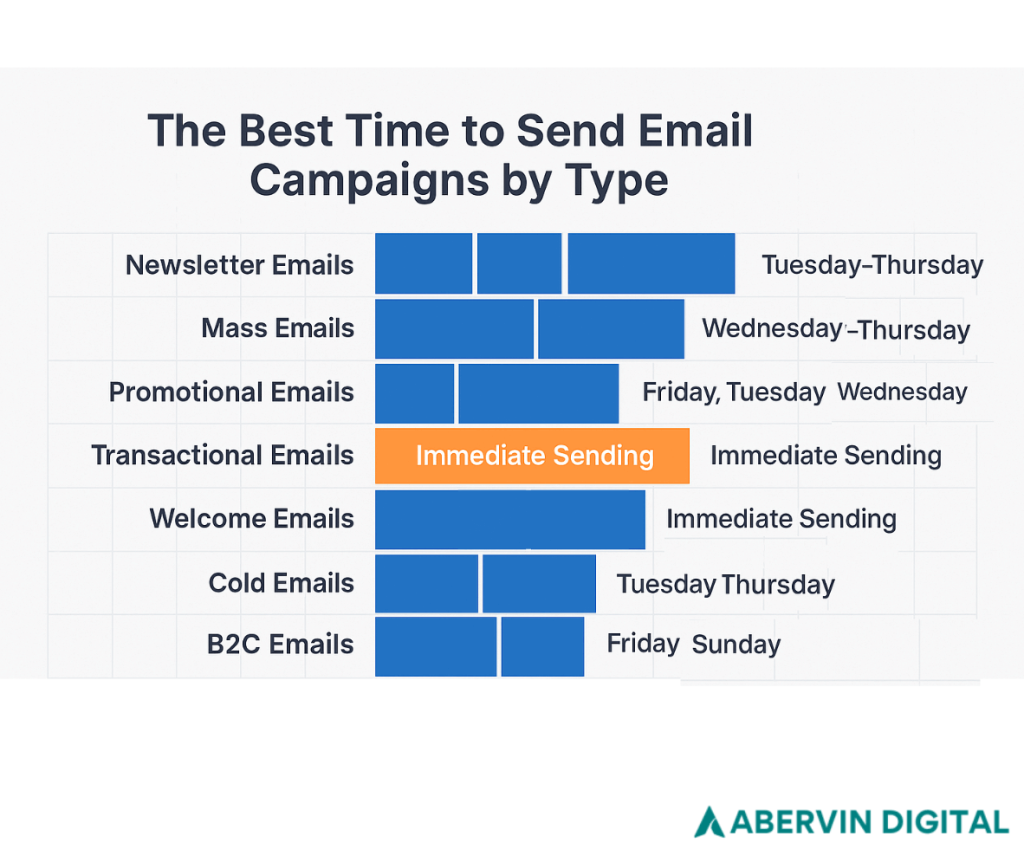
The best time to send marketing emails also depends on what you’re sending, who it’s for, and why you’re sending it.
Here’s how that makes sense…
Let’s say you want to send a product launch email. Your best chance for conversions is early in the morning when recipients are actively checking updates and news. Now, if you were sending a promotional email offering limited-time discounts, your campaign might do better if you send during lunch hours. This catches people while they’re taking a break.
The most successful emails ultimately match each reader’s preferences.
For instance, abandoned cart emails must be set up to send within a few hours of the prospect abandoning cart. This send time can get people interested again and help recover the sale. Reminder emails for expiring offers or webinars, are most effective in the evening. That’s when recipients have more free time to act
By considering the context and purpose of your email, you can figure our the best time to send emails for results.
Now, let’s dive into the best time to send emails based on the type of campaign:
Newsletter Emails
We’ve established that timing can significantly affect open rates and engagement. This is true for Newsletters as well. Midweek days, specifically Tuesday through Thursday, tend to perform best for businesses sending newsletters. During these days, recipients are more likely to be in work mode, making them more attentive to non-urgent content like newsletters.
Best Days:
- Tuesday to Thursday: Recipients typically settle into work routines by midweek. Sending between Tuesday and Thursday often means higher engagement
Best Times:
- Early morning (5–7 AM): Many people check emails upon waking, making this a great time to land at the top of their inbox.
- Late evening (8–11 PM): For night owls or those catching up before bed, newsletters sent during this window often receive attention.
Why It Works
Sending newsletters early in the morning reaches users as they check emails to start their day. This helps your content get seen before inboxes fill up. Evening sends benefit from a quieter time when recipients are unwinding. Both windows avoid mid-day email fatigue caused by work-related correspondence.
When Not To Send
Avoid sending newsletters on Saturdays and Sundays. Statistically, users are more drawn to lifestyle content making these days more beneficial to B2C businesses.
Several studies highlight the effectiveness of these times. For example, newsletters sent early in the day often see peak open rates of around 20-25%. Evening newsletters generate more clicks from readers seeking light content before bed.
Abervin Digital Expert Recommendation:
- Know Your Audience: If your business caters to a global audience, then segmenting based on time zones is a brilliant way to figure out what times work best for your audience in their different locations. Ensure that your ESP allows you segment by time zones. Our top three ESPs (Klaviyo, Mailchimp, ActiveCampaign) allow users segment their audience by time zones.
- Test Variability: A/B test your email content, days and times. to figure out the perfect schedule for your audience. Similarly, choose an ESP that provides multiple A/B Testing features.
trategically timed newsletters improve engagement. They help build a consistent rhythm with subscribers..
Now let’s take a look at the best time to send mass emails…
Mass Emails
Mass emails require careful timing for maximum visibility and engagement. This is especially true for campaigns targeting larger, more diverse audiences.
Poor timing can overload email service providers, cause delays and deliverability issues that reduce the effectiveness of your campaign.
Since millions of emails go out daily, cutting through the noise requires you to target times when your audience will open and engage with your message. Data shows midweek mass emails perform best. They get seen, read, and acted on.
Best Days:
- Wednesday and Thursday: Wednesday and Thursday are the sweet spot for sending a bunch of emails. Mondays suck because people are busy catching up, and by Friday everyone’s already checked out and thinking about the weekend.. This makes midweek perfect for getting your message noticed in a crowded inbox
Best Times:
- Between 10 AM and 2 PM: Midday works best as people typically check emails during their breaks or slower periods of the day. This window aligns with common workplace habits, particularly for professionals.
Why It Works
The smartest time to send emails is when most people are checking their inboxes but not drowning in a ton of urgent messages. Late morning to early afternoon provides the perfect balance between attention and action.
When Not to Send
Avoid sending emails on Mondays and Fridays because people often bury Monday messages under weekend backlog and overlook Friday emails as they prepare for the weekend.. Similarly, avoid sending emails late at night (after 9 PM), unless your audience includes night-shift workers, as most recipients are winding down and less likely to engage during this time.
Data Insights: According to marketing studies, mass emails sent midweek between 10 AM and 2 PM experience higher open rates, averaging 20–30%, and lower unsubscribe rates compared to emails sent during off-hours or less strategic days.
Abervin Digital Expert Recommendation:
- Segmentation Still Matters: Even for mass emails, segmenting by time zone ensures optimal delivery times for global audiences.
- Watch Out for Holidays: Avoid sending mass emails during major holidays or immediately after, as recipients often ignore non-essential messages during these periods.
By choosing the right midweek days and midday hours, your mass email campaigns are more likely to stand out in crowded inboxes, boosting both engagement and conversion rates.
Promotional Emails
Marketers design promotional emails to drive sales, launch offers, and keep audiences excited about the brand. The timing of your promotional emails can make or break their impact, influencing not only open rates but also click-throughs and conversions.
Unlike newsletters, which often focus on providing value-driven content, or mass emails, which aim to reach a broad audience, promotional emails need to create urgency and encourage immediate action. Whether you’re advertising a limited-time discount, launching a new product, or hosting a flash sale, understanding when your audience is most likely to engage can dramatically increase their effectiveness.
Best Days
- Friday: Choose Fridays if you’re in the eCommerce industry and you want to entice your customers to last-minute purchases. Friday B2C emails can have a sense of urgency especially for weekend shoppers.
- Tuesday & Wednesday: Recipients typically settle into routines by midweek, so sending on Tuesday or Wednesday helps your emails meet less crowded inboxes and get better engagement. Let’s explore the best times to send.
Best Times
- Early Morning (6–8 AM): Emails sent at this time are often opened by the peoples (in King Julien’s voice) planning their day or during their morning routines. This timing works particularly well for B2C audiences who like to move it move it. Okay… that’s enough King Julien jokes.
- Late Evening (8–10 PM): Taps into the relaxation window after work, when people are more likely to engage with online shopping or offers while unwinding.
Why It Works: Promotional emails rely heavily on timing to align with the recipient’s mindset. Morning emails cater to individuals checking inboxes before starting their day, while evening emails target those unwinding and engaging with offers in a less hurried environment. Sending emails around these periods increases your chances of higher visibility, click-through rates, and conversions.
When Not to Send
- Monday Morning: Since most inboxes flood on Monday mornings, recipients tend to overlook promotional emails.
- Midday Friday: Unless you want to make urgency a part of the campaign, sending emails during this period can result in low engagement as people mentally transition to weekend activities.
- Weekends (in general): Unless you are targeting specific shopping holidays or sales (like Black Friday), weekends tend to see lower engagement rates for non-time-sensitive offers.
Data shows Friday emails achieve the highest conversion rates, while midweek emails on Tuesday and Wednesday see strong open and click-through rates. Consumers engage more in the evening (after 8 PM), while early morning sends benefit from low competition and higher attentiveness.
Abervin Digital Expert Recommendation:
We recommend using email marketing software that allows you A/B test different times on these best days. This is because a lot of people send emails at peak times like 6 AM Friday. So A/B test sending campaigns a few minutes before and a few minutes after the best times. For example 5:50 AM or 6:10AM on Friday. This helps you get ahead of or avoid the peak time traffic on the ESPs end.
Data from email marketing tools like SendGrid and Campaign Monitor backs up what we’ve seen that the best time to send emails promoting anything is early morning and late evening because you grab attention when there’s less competition in the inbox.
Transactional Emails
Transactional emails are the backbone of effective customer communication because they deliver important information to customers or clients and are triggered by user actions like purchases, password resets, or account changes.
While their primary goal is to provide timely and relevant information, transactional emails also offer a unique opportunity to build trust and reinforce your brand and as such the right timing is super important here so these messages must arrive promptly to maintain user satisfaction and meet expectations.
And it’s for this reason that they are unique – there isn’t exactly a best time to send emails like transactional emails.
Best Days and Times
- Immediate Sending: Transactional emails should be sent instantly following the user’s action, regardless of the time of day or day of the week. Prompt delivery ensures that users receive real-time confirmations or instructions, enhancing their experience and trust in your service.
Why It Works
- User Expectation: Recipients anticipate immediate feedback after actions like purchases or password changes and just as prompt sending can lead to better brand reputation, upsell and cross-sell opportunities, delays can lead to confusion or concern.
- High Engagement: Transactional emails typically have higher open rates compared to promotional emails because they contain information the user is actively seeking.
When Not to Send
- Avoid Delays: Delaying transactional emails can frustrate users and diminish trust. Ensure your system is optimized to send these emails without lag.
- Do Not Batch Send: Unlike marketing emails, transactional emails should not be sent in batches or at scheduled times; they must be dispatched immediately to be effective.
Data Insights: Due to their high engagement, transactional emails can generate up to 6 times more revenue per email than standard marketing messages. According to Mailgun, transactional emails get way more opens than your usual promo emails.
Salesforce reports that transactional emails also outperform in engagement metrics, with CTRs ranging from 2% to 5%, depending on the industry.
Abervin Digital Expert Recommendation:
- Clear Subject Lines: Use straightforward subject lines that reflect the content, such as “Order Confirmation” or “Password Reset Instructions.”
- Relevant Content: Ensure the email contains all necessary information related to the user’s action, presented clearly and concisely.
- Consistent Branding: Maintain your brand’s voice and design elements to reinforce brand recognition and trust.
- Compliance: Ensure transactional emails comply with relevant regulations, such as including necessary contact information and avoiding promotional content that could reclassify the email under marketing laws.
By sending transactional emails immediately you get improved user satisfaction and maintain the integrity of your brand. Speaking of brand integrity, let’s explore how Welcome Emails influence your brand.
Welcome Emails
Welcome emails are your brand’s first handshake with new subscribers, customers, or users which means it’s your opportunity to make a strong, positive impression. These emails not only set the tone for your future relationship but also serve as an opportunity to highlight your value, provide helpful information, and guide recipients toward their next steps.
Sending them promptly, ideally within minutes of someone signing up or making a purchase capitalizes on the recipient’s interest while it’s at its peak. This immediate response reinforces trust, keeps your brand top of mind, and dramatically increases the likelihood of engagement.
There isn’t much to figuring out the best time to send emails that welcome your audience seeing as they are very much like transactional emails – only they go out to everyone, subscribers and buyers as opposed to transactional emails that are – well, transactional.
Best Days and Times
- Immediate Sending (Within 5 Minutes): The best time to send a welcome email is within 5 minutes of a user signing up or registering. This ensures your brand is still fresh in their mind, leading to higher open rates and engagement.
Why It Works
- Brand Recall: Prompt delivery keeps your brand top-of-mind, as recipients are still thinking about your service or product.
- User Momentum: New subscribers are often eager to explore further, and a timely welcome email can guide them toward the next step in the customer cycle. For some businesses this would be an upsell or a cross-sell.
- Trust Building: Quick communication builds trust, showcasing that your business is responsive and professional.
When Not to Send
- Delayed Welcome Emails: Sending a welcome email hours or days after sign-up can lead to decreased open rates and engagement. Recipients may have moved on, forgotten about their sign-up, or lost interest in your brand.
- Peak Inbox Hours: Avoid delivering welcome emails during times of high inbox traffic (e.g., mid-morning or early afternoon), as they risk getting overlooked.
Data Insights
- Open Rates: Welcome emails have an average open rate of 50-60%, which is significantly higher than the typical email marketing average of 20-25%.
- Timing Impact: Emails sent within 5 minutes of sign-up generate 4 times more opens compared to those sent after an hour.
- Click-Through Rates (CTR): Mailchimp reports that Welcome emails have an average CTR of 10-20%, making them some of the most engaging types of emails.
- Revenue Contribution: Data from Omnisend suggests that on average, welcome emails generate 320% more revenue per email than other promotional emails due to their high engagement and relevance.
Abervin Digital Expert Recommendation:
- Personalization: Address the recipient by name and reference their specific action (e.g., signing up, purchasing, or downloading).
- Clear Call-to-Action (CTA): Encourage the next step, whether it’s completing a profile, exploring your product, or claiming a special offer.
- Valuable Content: Include links to useful resources, onboarding guides, or exclusive perks to start the relationship on a positive note.
- Mobile Optimization: Ensure the email is mobile-friendly, as a significant portion of users will open it on their phones.
- Consistent Branding: Align the email’s design and tone with your website and brand identity for a cohesive experience.
Examples of Successful Welcome Emails
- Airbnb: Their welcome email highlights key features, includes a clear CTA, and welcomes users with a friendly tone.
- Asana: Quick-start emails that get you using the platform fast, so you don’t waste time figuring stuff out.
A well-timed, thoughtfully written welcome email not only boosts engagement but also sets the foundation for a strong, long-term relationship with your audience.
Cold Emails
Cold emails are a powerful tool for initiating connections, generating leads, and opening doors to new opportunities, whether you’re targeting businesses or consumers. However, because these emails often arrive uninvited, their success depends heavily on timing. When you reach out matters just as much as what you say. Think of it this way… if you ever needed to figure out the best time to send emails.. it’s when you’re sending cold emails.
At Abervin Digital, we’ve found that cold emails perform best when recipients receive them when they are most receptive which is typically midweek and mid-morning, when they are settled into their routines but not yet overwhelmed.
Follow the timing below when sending your cold emails and you can significantly increase the likelihood of your email standing out in a crowded inbox, capturing attention, and prompting a response.
Cold Email Best Days and Times
Best Days:
- Tuesday and Thursday: If you’re sending cold emails, Tuesdays and Thursdays usually crush it compared to other days. These midweek days strike the right balance between productivity and openness to communication, making recipients more likely to engage.
Best Times:
- Early Morning (8–10 AM): Sending cold emails early in the morning on Tuesdays and Thursdays capitalizes on catching recipients on the start of the workday when inboxes are actively checked.
Why It Works:
- Peak Productivity Periods: Sending during active work hours ensures your email is seen when recipients are engaged with their professional tasks.
- Avoiding Inbox Competition: Emails sent during these windows face less competition compared to high-traffic times like noon.
- Psychological Availability: Late afternoons can be less hectic, offering a better chance to capture the recipient’s attention.
When Not to Send
- Monday Mornings: Avoid the Monday rush, as professionals are often catching up on weekend backlogs.
- Fridays After 3 PM: Messages sent late on Fridays are likely to be ignored, with recipients heading into the weekend.
- Weekends: Unless targeting specific industries like hospitality or retail, weekends typically yield lower engagement for cold emails.
Data Insights
- Response Rates: Mailshake reports that emails sent on Tuesdays and Thursdays see response rates increase by 10-20% compared to other days.
- Open Rates: HubSpot analyzed campaigns sent using their platform and found early morning emails achieve open rates as high as 35%, while late afternoon emails see rates near 25%..
Abervin Digital Expert Recommendation:
- Personalization is Key: Use the recipient’s name, reference their company, or mention a specific challenge they face to make your email stand out.
- Keep it Brief: Busy professionals prefer concise, to-the-point emails that respect their time.
- Clear Subject Lines: Avoid spammy phrases; instead, use subject lines that hint at the value or relevance of your email. Check out our 5 proven subject line secrets to skyrocket your ROI.
- Follow-Up Strategy: Plan 2-3 follow-up emails spaced a few days apart to gently remind recipients about your initial outreach.
Sending emails to new prospects can make a huge difference in your business outcomes, as long as you take the time to plan and execute them thoughtfully and strategically. With thoughtful timing, strong personalization, and clear value propositions, your outreach will stand a much better chance of cutting through the noise and sparking meaningful conversations.
B2C Emails
B2C (business-to-consumer) emails are designed to engage individuals with personalized offers, updates, and promotions. The goal with these types of emails is to tap into consumer emotions, behaviors, and purchasing decisions. Unlike B2B (business-to-business) emails, which often target professionals during work hours, B2C emails focus on leisure time when people are more relaxed and open to browsing.
The timing of these emails is everything. Sending the right message at the wrong time can cost you an open, a click, or even a sale as consumers are most receptive during leisure hours when they have more time to browse and engage. Let’s explore the best time to send emails if you are in the B2C space.
B2C Emails Best Days and Times
Best Days:
- Friday: Works really well with end-of-week spending habits, as many consumers preparing for the weekend by shopping or planning activities.
- Sunday: Perfect for catching consumers relaxing at home and planning for the upcoming week.
Best Times:
- Evening (7–9 PM): Consumers are more likely to check personal emails after work or during downtime.
- Late Afternoon (4–6 PM): This can also be effective for promotions, as people begin to shift from work mode to leisure activities.
Why These Times Work
- Evening Hours: Consumers are typically unwinding, scrolling through emails, and open to considering offers.
- End-of-Week Urgency: Friday emails capitalize on payday behaviors and the psychological effect of limited-time weekend promotions.
- Weekend Relaxation: Sunday campaigns benefit from quieter inboxes and consumers planning for personal needs before the week begins.
When Not to Send
- Early Mornings (Before 7 AM): Consumers are more likely to overlook emails during their morning rush.
- Midweek Work Hours (10 AM–3 PM): Recipients often ignore B2C emails during work hours while they focus on more pressing tasks.
- Saturday Late Night (After 9 PM): Engagement rates dip as people are less likely to check emails during late-night activities.
Emails sent on Fridays see open rates increase by 10-15% compared to midweek campaigns, particularly in retail and entertainment industries.
According to data gathered by Omnisend, Sunday evenings boast some of the highest click-through rates (CTR) for personal shopping and lifestyle-focused content. While Sendinblue reports that emails sent between 7–9 PM yield up to 25% higher open rates for B2C campaigns, as recipients are winding down their day. Mobile devices account for 60-70% of opens during evening hours, so ensuring mobile-friendly design is key.
Abervin Digital Expert Recommendation:
- Segment Your Audience: Group consumers based on their shopping behavior, location, and interests to personalize content effectively. You can learn all about ecommerce email segmentation strategies in our detailed guide – Ecommerce Email Segmentation: 10X Your ROI in 2025
- Create a Sense of Urgency: Use countdown timers or language like “Hurry, sale ends Sunday night!” to encourage immediate action.
- Incorporate Visuals: Engaging visuals (e.g., lifestyle images or product showcases) appeal to B2C audiences and can boost click-through rates.
- Optimize for Mobile: With the majority of B2C emails opened on smartphones, ensure the design is responsive and loads quickly.
- A/B Test Timing: Test different send times to discover when your specific audience is most active and responsive.
Examples of Successful B2C Campaigns
- Amazon: Frequently uses Friday and Sunday evenings to promote time-sensitive deals and sales, driving high engagement.
- Netflix: Sends tailored content recommendations on Sundays to keep users engaged as they plan their week.
B2C email timing is all about syncing with consumer habits and leisure hours. By understanding when your audience is most likely to engage, you can create campaigns that resonate, convert, and build brand loyalty. We’ve put together our proven B2C Marketing tips for 2025 in this Ultimate Guide to Winning Customers and Building Loyalty.
Now, keep in mind that understanding the right timing for a variety of email campaigns is a great start, but to get the best results, you need to focus on what works specifically for your audience.
Every business is different, and finding the best time to send emails for your kind of business can help you connect better, boost engagement, and get more results. Let’s get into it.
How to Find the Best Time to Send Emails For Your Business
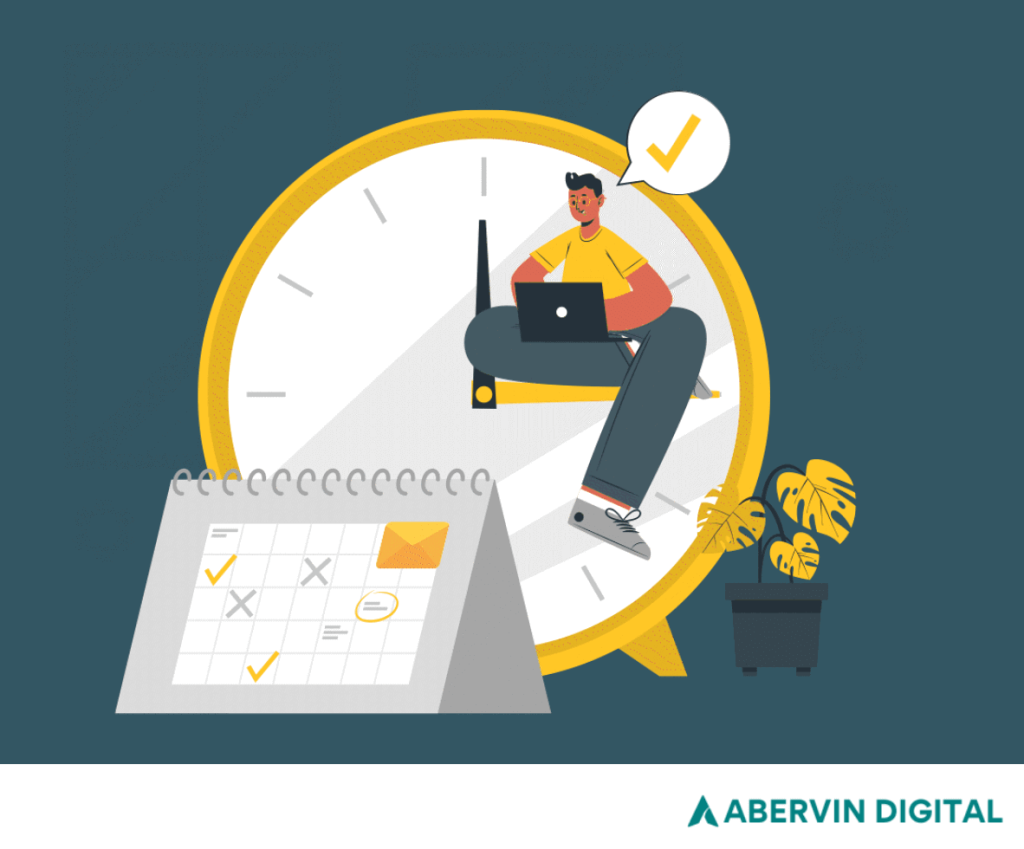
Timing your emails right isn’t a magic formula. Some people check their inbox at breakfast, others at midnight. You’ve got to look at your data, think strategically, and really know your audience’s habits. At Abervin Digital, we’ve seen firsthand how choosing the right timing can make a big difference in how many people open and respond to your emails.
As easy as it sounds, getting the most out of your email efforts really comes down to reviewing past email performance, planning based on the type of email you’re sending, and factoring in time zones and behaviors of your recipients to boost visibility and action.
Strategies for Perfect Timing in Your Email Campaigns
1. Test, Learn, and Adapt (A/B Testing)
Try sending your emails at various times throughout the day or week, then carefully review the results to see which timing works best for engaging your audience and improving overall performance. Split your audience into two groups. You can send Group A an email at 10 a.m. and Group B at 8 p.m. Compare open rates, CTR, and conversions.
2. Segment by Time Zone
If you have a global audience, consider segmenting by time zone to hit the right windows for each region. Send emails to U.S. subscribers in the morning but adjust for evening engagement for your European audience.
3. Deploy Event-Based Campaigns
Send reminders for Valentine’s Day gift purchases during evening hours the week prior, when consumers are in a decision-making mindset.
Email marketing is about more than just hitting “send” on the perfect message… it’s also about understanding your audience’s routines and leveraging data to help you deliver it at the perfect moment. By analyzing data, testing strategies, and keeping your audience’s habits in mind, you can significantly boost engagement, drive conversions, and build lasting connections.
Need expert help? At Abervin Digital, we specialize in creating email strategies that work. Contact us today at +1 (720) 583-5547 or visit Abervin Digital to explore our services and pricing.


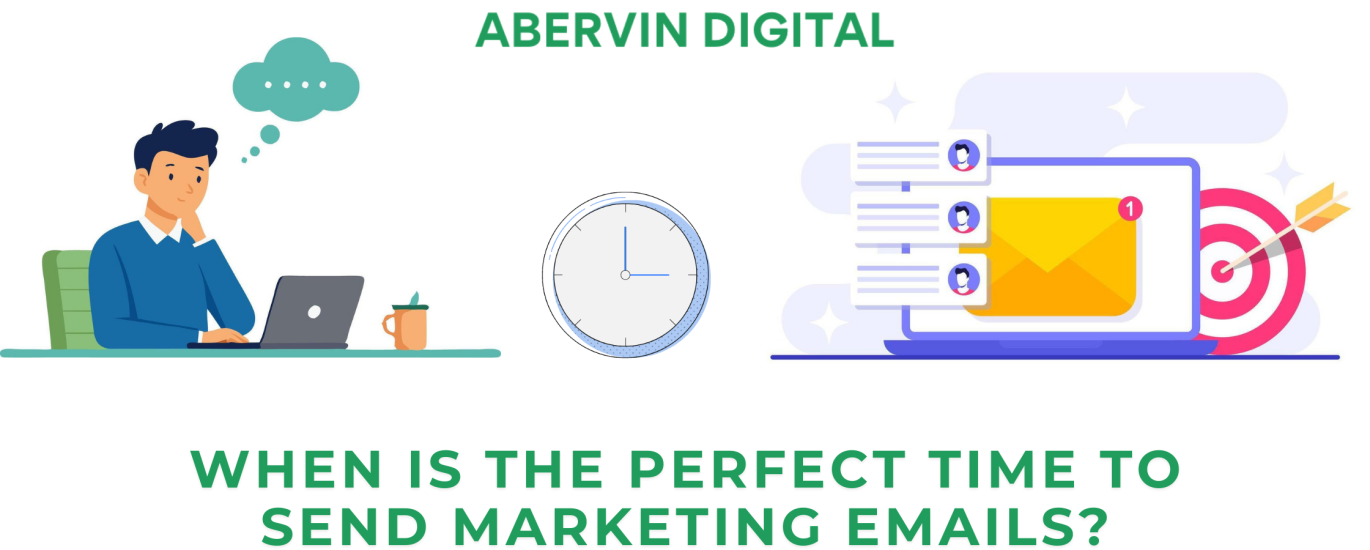





Great post! This is so helpful! You picked a key topic to focus on. I made a free guide that shows how to build an email marketing plan step by step. It covers setting goals, tracking results, and fixing common mistakes. Visit the link to see it. Thanks for sharing such helpful, straightforward tips!